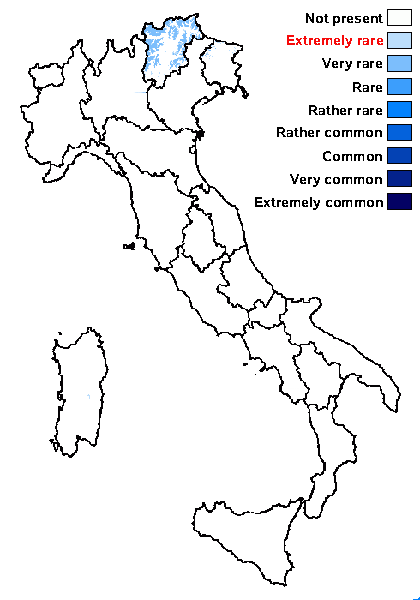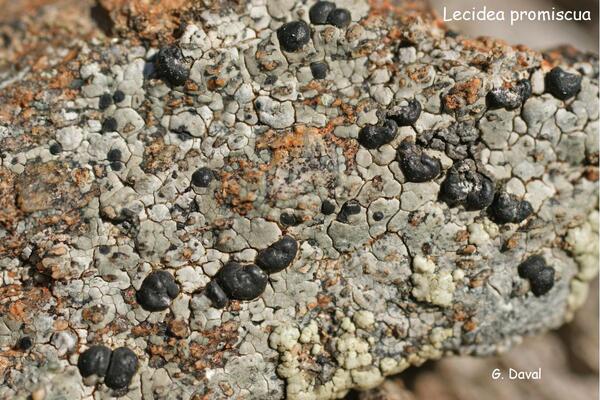Lecidea promiscua Nyl.
Flora, 57: 357, 1874.
Synonyms: Lecidea dilabens Th. Fr.; Lecidea gregalis Arnold; Lecidea speciosa Müll. Arg.
Distribution: N - Frl (TSB 2738), TAA (Nascimbene & al. 2022). C - Sar.
Description: Thallus crustose, episubstratic, rather thick, white to grey white, areolate, without a distinct prothallus, forming patches < 10 cm in diam. Medulla I+ intensely blue-violet. Apothecia lecideine, black, usually numerous, sessile and strongly constricted at base, rounded to angular by mutual compression, 0.5-2(-3) mm across, with a flat to convex, epruinose or slightly pruinose disc, and a thin, weakly raised, persistent proper margin. Proper exciple greenish black along a thin, peripheral rim partly extending below the hypothecium, pale grey or colourless within, C-; epithecium dark green to greenish black, N+ purple; hymenium colourless of pale green in upper part, 40-55 μm high, I+ blue; paraphyses coherent, the apical cells swollen; hypothecium medium to dark brown. Asci 8-spored, clavate, Lecidea-type. Ascospores 1-celled, hyaline, oblong or oblong-ellipsoid, 7.5-11.7 x 3.2-4.7 μm, 2-3.2 times as long as wide. Pycnidia black, semi-immersed. Conidia bacilliform to filiform. Photobiont chlorococcoid. Spot tests: thallus K-, C-, KC-, P-, UV-. Chemistry: thallus with 2’-0-methylperlatolic acid (major).Note: a member of the difficult L. auriculata-complex, closely related to L. promiscens and with a similar ecology, apparently common in the Alpine belt of the Alps, but overlooked.
Growth form: Crustose
Substrata: rocks
Photobiont: green algae other than Trentepohlia
Reproductive strategy: mainly sexual
Commonnes-rarity: (info)
Alpine belt: very rare
Subalpine belt: extremely rare
Oromediterranean belt: extremely rare
Montane belt: absent
Submediterranean belt: absent
Padanian area: absent
Humid submediterranean belt: absent
Humid mediterranean belt: absent
Dry mediterranean belt: absent

Predictive model
Herbarium samples
Growth form: Crustose
Substrata: rocks
Photobiont: green algae other than Trentepohlia
Reproductive strategy: mainly sexual
Commonnes-rarity: (info)
Alpine belt: very rare
Subalpine belt: extremely rare
Oromediterranean belt: extremely rare
Montane belt: absent
Submediterranean belt: absent
Padanian area: absent
Humid submediterranean belt: absent
Humid mediterranean belt: absent
Dry mediterranean belt: absent

Predictive model
| Herbarium samples |
 Index Fungorum
Index Fungorum
 GBIF
GBIF


